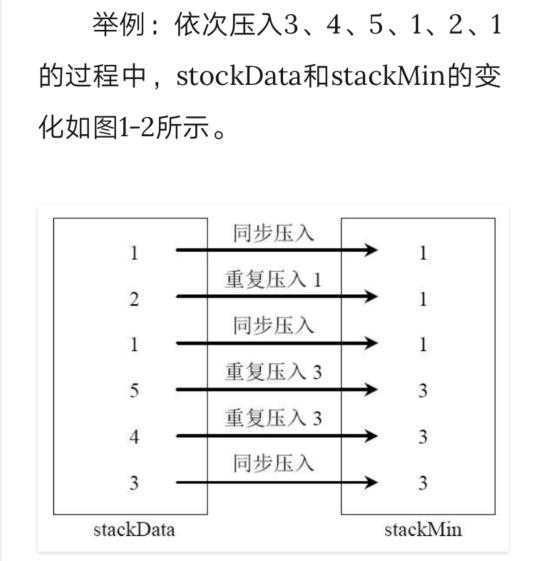含有最小值的栈
思路:用一个辅助栈来记录主栈的最小值,对于主栈来说有两种操作:插入,弹出。
插入:当向主栈插入元素时,有三种情况:
如图,stockData为主栈,stackMin为辅助栈,当向主栈插入元素时:

弹出:当弹出主栈元素时,辅助栈也需要弹出元素。

#include <stdio.h> #include<malloc.h> //声明链表节点类型 typedef struct LISTtag LISTtagNode; struct LISTtag{ int value; LISTtagNode *next; }; int size=0; int sizeminor = 0; //创建链表 LISTtagNode * create(){ LISTtagNode *head; head = (LISTtagNode*)malloc(sizeof(LISTtagNode)); head->next = NULL; return head; } //在链表头新增节点 int push(LISTtagNode *head,int value){ if(head == NULL){ return -1; } //新建节点 LISTtagNode *node; node = (LISTtagNode*)malloc(sizeof(LISTtagNode)); //节点赋值,此节点跟在头节点后 node->value = value; node->next = head->next; head->next = node; size++; return 1; } //打印链表 int PrindLinKList(LISTtagNode *head){ if(head == NULL){ return -1; } printf("\n "); LISTtagNode *t = head; while (t->next != NULL) { t = t->next; printf("%d ", t->value); } return 1; } int pop(LISTtagNode *head){ if(head ==NULL){ return -1; } LISTtagNode *node; int index = 0; while(head->next!=NULL&&index<1){ node = head->next; index++; } if(index == 1){ printf("\n主栈弹出元素:%d \n",node->value); if(head->next->next != NULL){ head->next = head->next->next; }else{ head->next =NULL; } free(node); size--; return 1; } return -1; } //打印栈顶元素 int top(LISTtagNode *head){ if(head ==NULL){ return -1; } LISTtagNode *node; int index = 0; while(head->next!=NULL&&index<1){ node = head->next; index++; } if(index == 1){ printf("\n栈顶元素:%d\n",node->value); return 1; } return -1; } int empty(LISTtagNode *head){ if(head ==NULL){ return -1; } if(head->next!=NULL){ return 0; } return 1; } //链表长度 int length(LISTtagNode *head){ if(head ==NULL){ return -1; } return size; } //在链表头新增节点 int pushminor(LISTtagNode *head,int value){ if(head == NULL){ return -1; } if(head->next ==NULL){ //新建节点 LISTtagNode *node; node = (LISTtagNode*)malloc(sizeof(LISTtagNode)); //节点赋值,此节点跟在头节点后 node->value = value; node->next = head->next; head->next = node; sizeminor++; return 1; }else{ if(head->next->value >= value){ //新建节点 LISTtagNode *node; node = (LISTtagNode*)malloc(sizeof(LISTtagNode)); //节点赋值,此节点跟在头节点后 node->value = value; node->next = head->next; head->next = node; sizeminor++; return 1; }else{ //新建节点 LISTtagNode *node; node = (LISTtagNode*)malloc(sizeof(LISTtagNode)); //节点赋值,此节点跟在头节点后 node->value = head->next->value; node->next = head->next; head->next = node; sizeminor++; return 1; } } } int popminor(LISTtagNode *head){ if(head ==NULL){ return -1; } LISTtagNode *node; int index = 0; while(head->next!=NULL&&index<1){ node = head->next; index++; } if(index == 1){ printf("辅助栈弹出元素:%d\n",node->value); if(head->next->next != NULL){ head->next = head->next->next; }else{ head->next =NULL; } free(node); sizeminor--; return 1; } return -1; } int main () { //主栈 LISTtagNode *head = create(); //辅助栈 LISTtagNode *headminor = create(); //向链表插入元素 push(head,7); pushminor(headminor,7); //PrindLinKList(headminor); top(headminor); //向主栈插入元素 push(head,9); //向辅助栈插入元素 pushminor(headminor,9); //打印辅助栈的栈顶元素,就是最小值 top(headminor); //向链表插入元素 push(head,23); pushminor(headminor,23); top(headminor); //向链表插入元素 push(head,2); pushminor(headminor,2); top(headminor); //弹出链表元素 pop(head); popminor(headminor); top(headminor); return 0; }
原文:https://www.cnblogs.com/-wenli/p/12641322.html